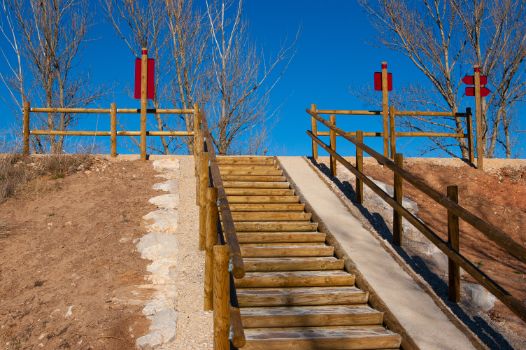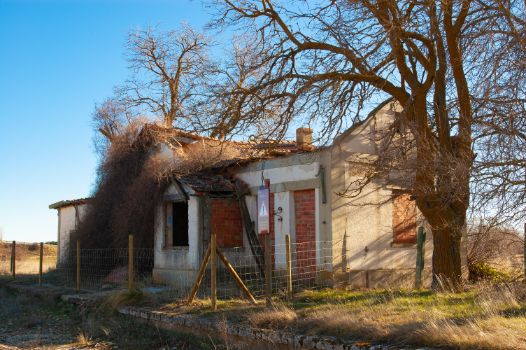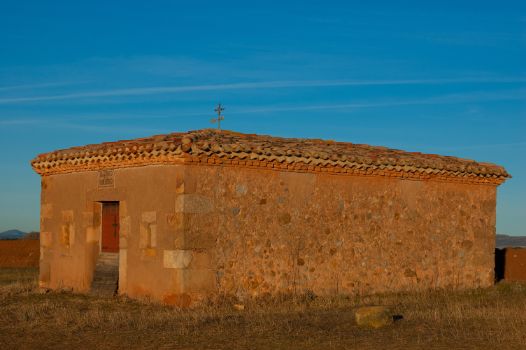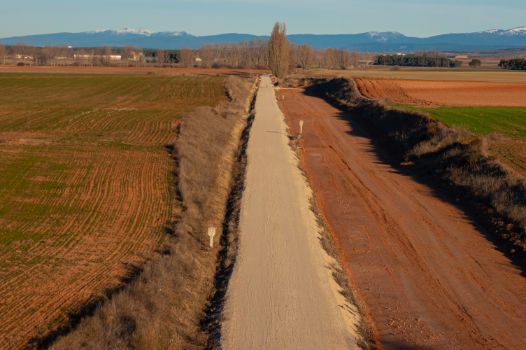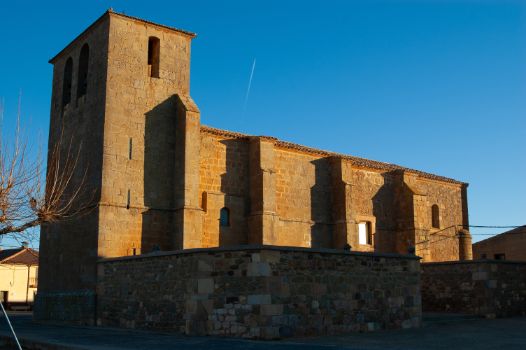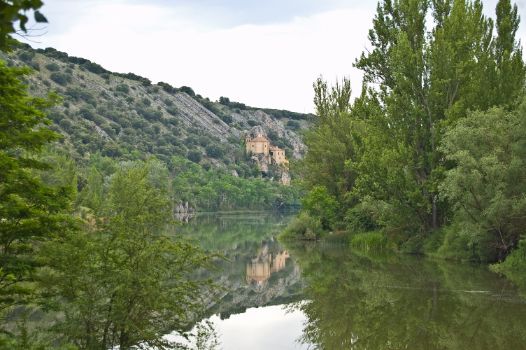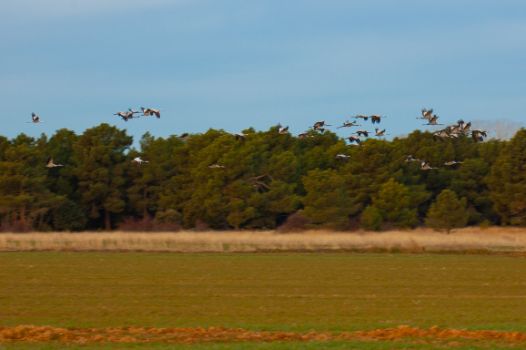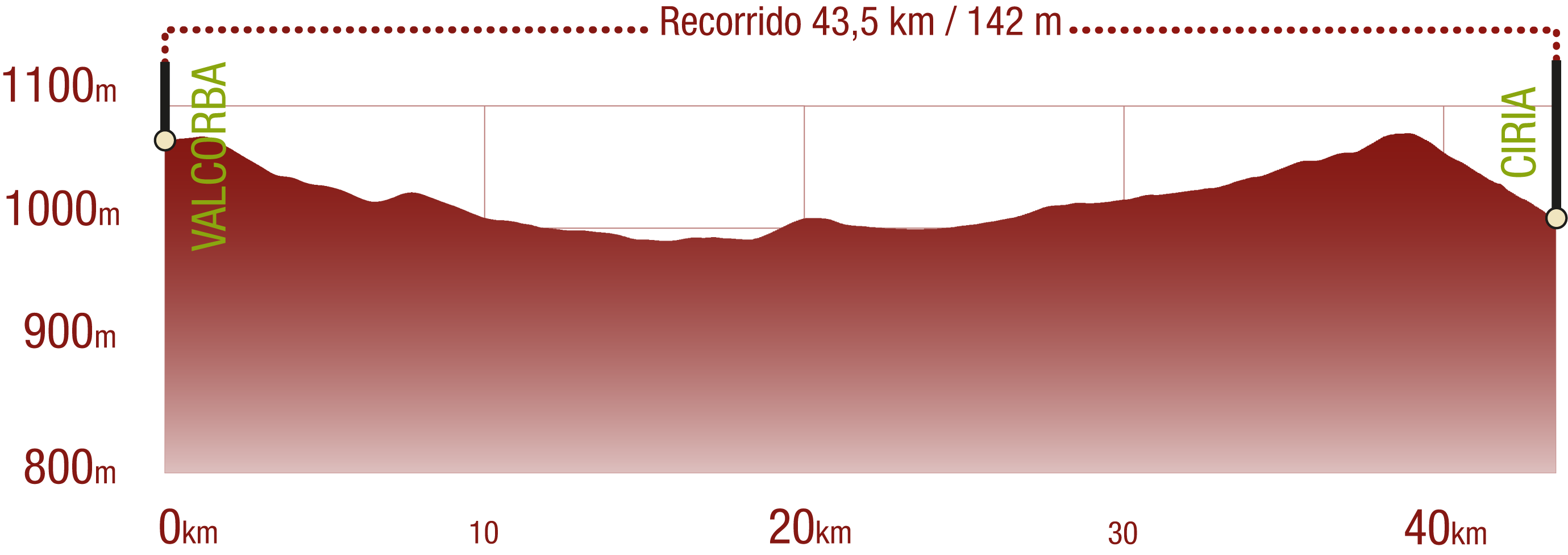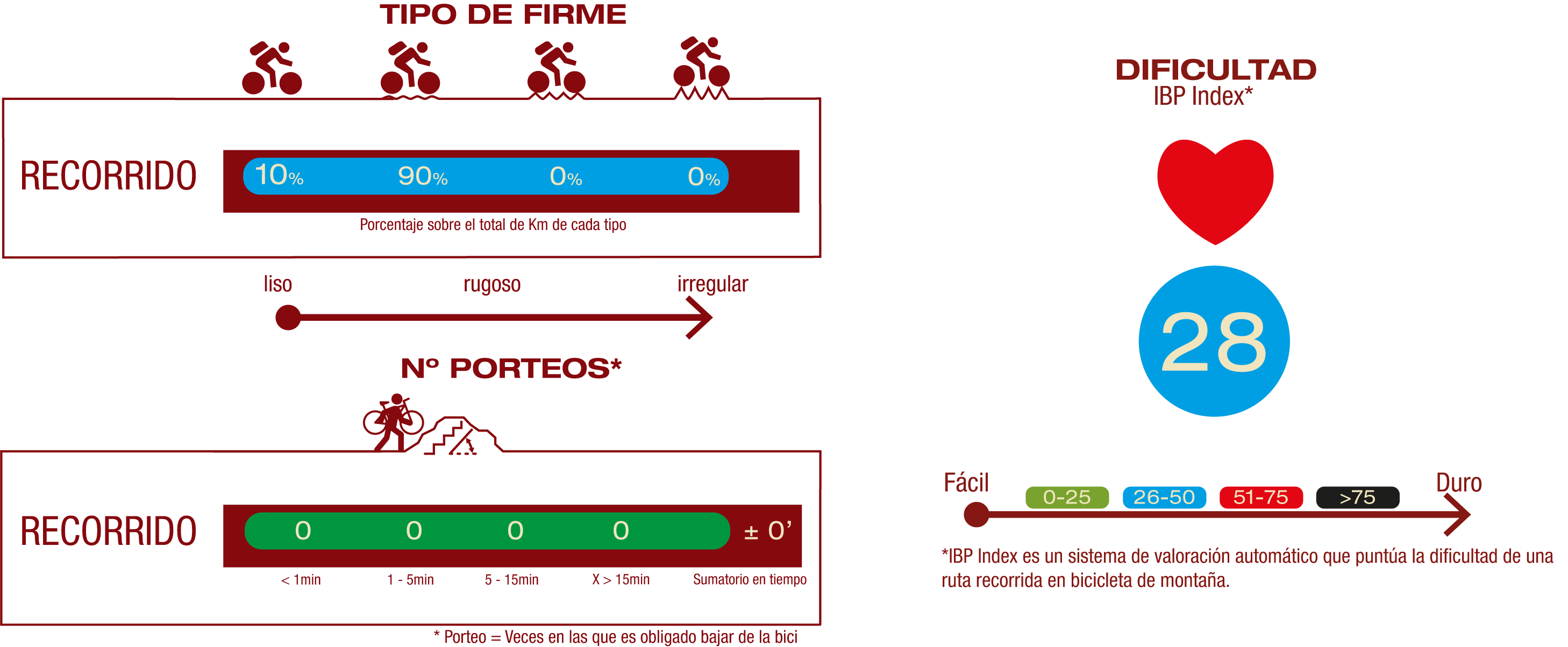
Net of Natural
Trails

Stage: Soria (Valcorba industrial estate) - Cabrejas del Campo
Description
Soria, the River Duero and the fields of Gómara: source of inspiration for Bécquer and Machado.
The Santander-Mediterranean Railway lives on in the memory in Soria thanks to the iconic iron bridge over the River Duero. The railway bids farewell to Soria, a city that has been home to great writers and inspired one of the great hits of Spanish 1980s pop-rock in Camino Soria by Gabinete Cagliari. Like them, the likes of Bécquer and Machado ambled through the fields of Campos de Gómara, leaving an indelible mark on the culture of the region.
- - - - - - - -
PLEASE NOTE!
THIS STAGE IS CURRENTLY INCOMPLETE. SOON IT WILL BE POSSIBLE TO COMPLETE THE ENTIRE STAGE TO CABREJAS DEL CAMPO TO FULLY APPRECIATE THIS BEAUTIFUL LANDSCAPE.
THANK YOU FOR YOUR UNDERSTANDING.
- - - - - - - -

After Soria station, the old railway continued its journey near what is now Los Pajaritos Sports Complex. It passed in front of the Shrine of San Saturio and crossed the River Duero over the imposing metal bridge. From there, it ascended parallel to the N-234 road through the valley formed by Monte de las Ánimas and the Sierra de Santa Ana mountains, before reaching what is now Valcorba Industrial Estate.
At present, the stage begins at the city limits of Soria and the aforementioned industrial estate, faithfully following the old railway line and its characteristic gentle slope. Some distance away, on our left sits the small village of Ontalvilla de Valcorba, belonging to the municipality of Alconaba, with its Church of Santa Cruz.
Shortly after the four-kilometre marker, we reach the village of Martialay, where we can visit the Church of San Justo y Pastor and the old washing place. Later we reach the old halt station, an ideal spot for a break. The interpretative panel here provides detailed information on the landmarks of this route. There is also another smaller panel specifically for cyclists, particularly useful for planning and getting the most from the excursion.

Continuing, which is dominated by fields of unirrigated cereal crops, we pass small villages on both sides of the trail. On the left we see Duáñez and on the right Cubo de Hogueras, with their respective Churches of Santa Cruz and La Presentación. After passing through these villages, the old railway line crosses the Cañada Real Soriana Oriental, a 75-metre wide livestock trail that was essential for the transhumance of large flocks of sheep. This route, managed by the Mesta Council since its creation in 1273 by Alfonso X the Wise, was for centuries an important economic engine for the country. The section that passes through the Region of Madrid is today the Cañada Real Soriana Oriental Nature Trail.
To the right of the path, we see the village of Carazuelo, with its small church built in 1962 dominating the landscape, standing on a small promontory. Shortly after kilometre ten of the route, we reach the old Candilichera halt, now in ruins. On our left is the village of Candilichera, with its Church of Nuestra Señora de La Asunción, its principal landmark.

Our route enters the fields of Campos de Gómara, where the small lagoons of Honda, Herrada and Herrera and others form the Gómara Lagoon Complex, amid the farmland. It is a paradise for nature lovers, boasting an impressive biodiversity, and birdlife in particular. The lagoons are an important resting place for migratory birds, and it is common to see huge flocks of cranes (Grus grus) on their long journeys.
Continuing on the Greenway, we reach the Cabrejas del Campo rest area, an ideal spot for a break. A short distance away is the village of the same name, where we can visit the impressive gothic Church of San Juan Bautista. Soon we reach the old halt station, marking the end of this stage of the Santander-Mediterranean Nature Trail, Soria (Valcorba) to Cabrejas del Campo.
Managing Entities
Sites of Interest
Puntos de interés
Culture
Hydrography
Infrastructure
Municipality
Profile
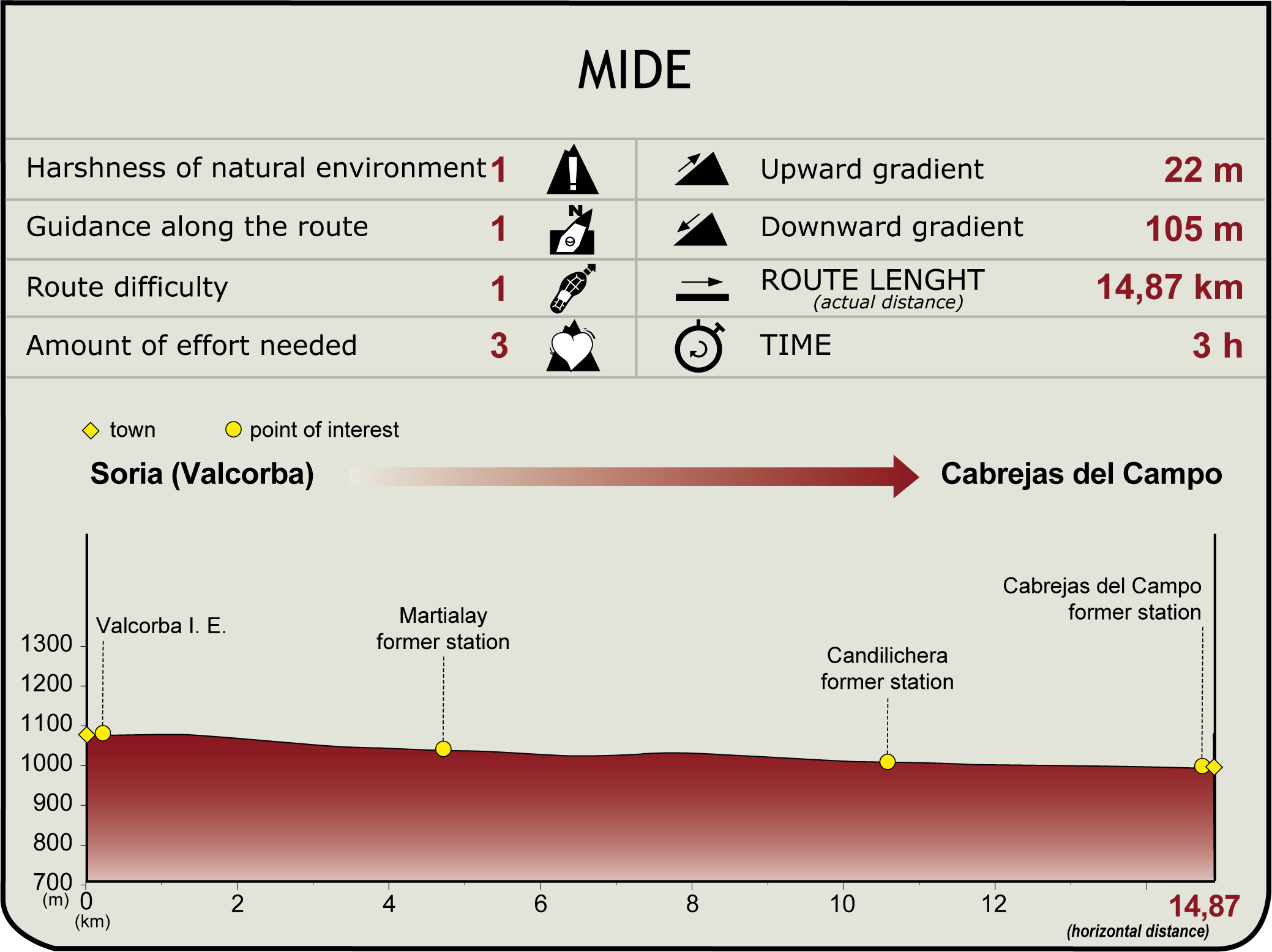
(Calculated according to the MIDE criteria for an average excursionist with a light load)
Highlights
Soria
Soria, capital of the province of the same name, was founded at a strategic location on the banks of the River Duero. The human presence here goes all the way back to between 3000 and 2000 BC. We know this from the cave paintings found on Mount Valonsadero.
Soria's impressive architectural heritage is there for all to see, both in the city centre and on the banks of the River Duero. In the city, the Church of Santo Domingo is an outstanding example of the city's historical legacy. On the banks of the Duero, stand the Shrine of San Saturio and the Monasteries of San Juan de Duero and San Polo, important historical buildings.
Soria is also known for its vast natural heritage, which is reflected in its gastronomy. The city is something of a Mecca for mushroom lovers, and the city celebrates events like the International Congress of Mycology.
Local festivals are no less important, with the week-long patron saint celebrations, in honour of San Saturio, the highlight.
Multimedia
Downloads
GPS Downloads
Cyclability
Esta Cicloetapa se corresponde con el tramo entre el polígono de Valcorba y Ciria del Camino Natural
RECOMENDACIONES DE SEGURIDAD
-Precaución en el cruce de carreteras.
-Se deben extremar las precauciones en el tramo de más de 2,5 km que avanza por el P. I. Villalonquejar por ciclo carril regulado a 30 km/h compartido con vehículos a motor.
-El tramo urbano de la ciudad de Burgos se realiza por un carril bici sin dificultad alguna desde el punto de vista técnico, únicamente se deberán extremar las precauciones en los numerosos cruces de carreteras y calles dentro de la ciudad con trafico motorizado. Todos esos cruces están perfectamente señalizados y algunos de ellos dotados son semáforo adaptado para cicloturistas.
-Existen dos túneles (Túnel del Callejón 121 m y Túnel de la Hoz 84 m) que no revisten dificultad ni riesgo alguno, a pesar de ello se recomienda disponer de una linterna.
REDOMENDACIONES GENERALES
-Infórmate sobre los aspectos técnicos de la ruta y sobre la meteorología del día.
-Cuida del medio ambiente. Procura no molestar a los animales ni deteriorar la vegetación. Respeta las zonas privadas.
-Debes dar prioridad a los peatones y cumplir con las normas generales de circulación.
-El entorno por el que vas a circular es abierto, de libre circulación y escenario de múltiples actividades (deportivas, forestales, ganaderas y agrícolas). Mantén una actitud comprensiva, prudente, responsable y respetuosa.






